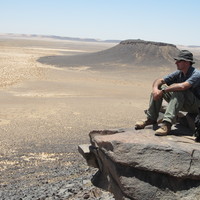
Yorke Rowan
I am Research (Full) Professor in the Archaeology of the Southern Levant at the Institute for the Study of Ancient Cultures, University of Chicago. I co-direct the Galilee Prehistory Project, an ISAC field program, and co-direct Kites in Context, an ISAC and UPenn project in the Black Desert of eastern Jordan. I also co-direct the Eastern Badia Archaeological Project, which involves survey and excavation in the Wadi al-Qattafi and Wisad Pools in the Black Desert. My most recent edited volumes include "The Social Archaeology of the Levant: from Prehistory to the Present" (Cambridge, with A. Yasur-Landau and E. Cline) and “Beyond Belief: The Archaeology of Religion and Ritual” which draws together theoretical and methodological studies concerning ancient religion and ritual. Other edited volumes include “Culture, Chronology, and the Chalcolithic: Theory and Transition”, “New Approaches to Old Stones: Recent Studies of Ground Stone Artifacts,” and “Marketing Heritage: Archaeology and the Consumption of the Past.” I am currently preparing a monograph on the survey and excavations of Marj Rabba, the first phase of the Galilee Prehistory Project, and a monograph on excavations at Tel Yaqush, an Early Bronze Age site in the Jordan Valley excavated by the late Doug Esse and David Schloen.
Phone: 773.702.0086
Address: The Institute of Ancient Cultures
University of Chicago
1155 East 58th St
Chicago, IL 60637
Phone: 773.702.0086
Address: The Institute of Ancient Cultures
University of Chicago
1155 East 58th St
Chicago, IL 60637
less
InterestsView All (33)
Uploads
Books by Yorke Rowan
The first phase of excavations at Shiqmim took place between 1979 and 1984 and were described in Shiqmim I, Parts i and ii (BAR Publishing, 1987). Shiqmim II reports on the second phase of excavations at this complex site and contributes to a greater understanding of its Chalcolithic stratigraphy, architecture, and chronology. It includes the project research design and history framed in an anthropological archaeology perspective, primary excavation data, and a Bayesian analysis of radiocarbon dates from Shiqmim presented in comparison with dates from contemporary regional sites.
Papers by Yorke Rowan
architectural planning, demonstrating awareness of basic geometric principles. New radiometric assays suggest that adaptive processes were profoundly influenced by episodes of climatic and environmental change, including the longer 8.2 ka event. Emerging data from north-west Saudi
Arabia require Wisad Pools to be examined in the context of Arabian Neolithization, considering the possibility that the Black Desert Neolithic was a point of departure for some aspects of that process.
The first phase of excavations at Shiqmim took place between 1979 and 1984 and were described in Shiqmim I, Parts i and ii (BAR Publishing, 1987). Shiqmim II reports on the second phase of excavations at this complex site and contributes to a greater understanding of its Chalcolithic stratigraphy, architecture, and chronology. It includes the project research design and history framed in an anthropological archaeology perspective, primary excavation data, and a Bayesian analysis of radiocarbon dates from Shiqmim presented in comparison with dates from contemporary regional sites.
architectural planning, demonstrating awareness of basic geometric principles. New radiometric assays suggest that adaptive processes were profoundly influenced by episodes of climatic and environmental change, including the longer 8.2 ka event. Emerging data from north-west Saudi
Arabia require Wisad Pools to be examined in the context of Arabian Neolithization, considering the possibility that the Black Desert Neolithic was a point of departure for some aspects of that process.
The paper presents the first dates from the Qe’an of this region and the outline sedimentology. Much of the fill is of Holocene age, which leads to discussion of climate and landscape change over the last 15,000 years, particularly due to the close geographical relationship between these basins and archaeology. Our optically stimulated luminescence and radiocarbon dating of the basin fill suggests that there was significantly more space in the landscape for water storage in the early Holocene, which may have therefore provided this resource for people and their livestock or game for a longer duration each year than that seen today. Linked to this are hypotheses of a more vegetated landscape during this time period. Given the environmentally marginal nature of our study area subtle changes in landscape and/or climate, and human exploitation of these resources, could have led to significant, and likely detrimental for its inhabitants, environmental impacts for the region, such as desertification. Our data are suggestive of desertification occurring, and sets up a clear hypothesis for testing by future work in the region.
2011 Transitions in macehead manufacture in the ancient Levant: a case study from Nahal Tillah (Tel Halif Ter-race), Israel. In Daily Life, Materiality, and Complexity in Early Urban Communities of the Southern Levant: Papers in Honor of Walter E. Rast and R. Thomas Schaub, edited by M.S. Chesson, W. Aufrecht, and I Kuijt, pp. 199–218. Eisenbraun, Winona Lake, IN.